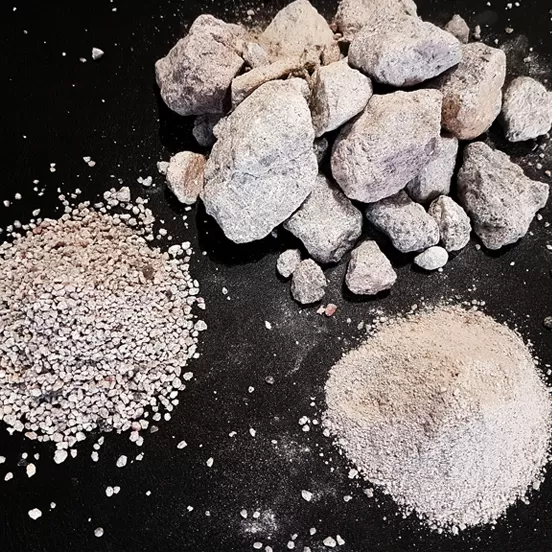When raw perlite is heated rapidly above 900 ºC, it explodes like corn kernels with the evaporation of the sap within it, and countless pores are formed on the perlite, which expands with heat. Expanded perlite in this way provides excellent heat and sound insulation.
RAW PERLITE PROPERTIES
|
CONSTUCTION
|
FOUNDRY
|
FILTRATION
|
CRYOGENIC
|
AGRICULTURE
|
CONSTRUCTION CHEMICALS
|
PLASTIC AND RUBBER
|
|
0,074-0,30 mm
|
0,00-0,60 mm
|
0,074-0,30 mm
|
0,074-0,30 mm
|
0,074-0,30 mm
|
0,074-0,30 mm
|
0,074-0,20 mm
|
|
0,074-0,40 mm
|
0,074-0,60 mm
|
0,15-0,40 mm
|
0,15-0,40 mm
|
0,074-0,40 mm
|
0,074-0,40 mm
|
0,074-0,30 mm
|
|
0,20-0,40 mm
|
0,15-0,60 mm
|
0,074-0,40 mm
|
0,074-0,40 mm
|
0,15-0,40 mm
|
0,20-0,40 mm
|
0,15-0,40 mm
|
|
0,15-0,40 mm
|
0,60-1,20 mm
|
0,074-0,50 mm
|
0,20-0,40 mm
|
0,074-0,50 mm
|
0,15-0,40 mm
|
0,074-0,40 mm
|
|
0,074-0,50 mm
|
1,00-2,00 mm
|
0,074-0,60 mm
|
0,074-0,50 mm
|
0,074-0,60 mm
|
0,074-0,50 mm
|
0,20-0,40 mm
|
|
0,10-0,50 mm
|
1,20-2,40 mm
|
0,15-0,60 mm
|
0,00-0,60 mm
|
0,15-0,60 mm
|
0,10-0,50 mm
|
0,15-0,40 mm
|
|
0,00-0,60 mm
|
1,20-2,80 mm
|
0,60-1,20 mm
|
0,074-0,60 mm
|
0,60-1,20 mm
|
0,00-0,60 mm
|
0,074-0,50 mm
|
|
0,074-0,60 mm
|
2,00-2,80 mm
|
1,20-2,80 mm
|
0,15-0,60 mm
|
1,20-2,40 mm
|
0,074-0,60 mm
|
0,10-0,50 mm
|
|
0,15-0,60 mm
|
2,00-4,00 mm
|
2,00-4,00 mm
|
0,60-1,20 mm
|
1,20-2,80 mm
|
0,15-0,60 mm
|
|
|
0,60-1,20 mm
|
|
|
1,20-2,80 mm
|
2,00-2,80 mm
|
0,60-1,20 mm
|
|
|
1,20-2,40 mm
|
|
|
2,00-4,00 mm
|
2,00-4,00 mm
|
1,20-2,40 mm
|
|
|
1,20-2,80 mm
|
|
|
|
|
|
|
|
2,00-2,80 mm
|
|
|
|
|
|
|
|
2,00-4,00 mm
|
|
|
|
|
|
|
When raw perlite is heated rapidly above 900 ºC, it explodes like corn kernels with the evaporation of the sap within it, and countless pores are formed on the perlite, which expands with heat. Expanded perlite in this way provides excellent heat and sound insulation.
Perlite is a name given to naturally occurring silica-based volcanic rocks.
The most important feature that distinguishes perlite from other volcanic glasses is that it can expand four to twenty-four times its original volume when heated around its softening temperature. This expansion depends on the 2-6% sap (crystal water) in raw perlite.
Perlite, meaning pearl stone, is a glassy volcanic rock with different colors from shades of gray to black. This form is called Raw Perlite.
Raw Perlite is widely used in the construction industry because it contains siliceous and aluminum components in its chemical composition and shows hydraulic (pozzolanic) activity by chemically reacting with calcium-based binders. With this feature, it is an excellent aggregate that provides economy and durability compared to cement.
Raw Perlite is the natural form of perlite that has not been expanded by heat. First of all, raw perlite is crushed and classified into appropriate sizes. It is then heated and the volume of perlite is increased. Special furnaces are used to heat raw perlite. As a result of the process, expanded perlite is ready to be used.
Unexpanded perlite also has various areas of use: concrete tile production, thin and rough plaster, production of sewer pipes, roof, and terrace water insulation, swimming pool construction, asphalt filling material in highway construction, as skid sand in railways, and constructions that receive water by taking advantage of its resistance to freezing. available for use.
USAGE AREAS OF RAW PERLITE
* In the Construction Industry
* In Metallurgical (Casting) Industry
*In Ceramic Industr
*As skid sand in railways,
*As an abrasive in the abrasive industry
*In water treatment plants
*It is used as asphalt filler material in highway construction.
USAGE AREAS:
– In Plaster and Construction Chemicals Production
– In Interior and Exterior Construction Plasters,
– It is used in constructions that receive water because it is resistant to frost.
– Roof and terrace waterproofing
– In swimming pool construction
– Since it is resistant to acids and bases, it is especially used in the production of sewer pipes.
– In brick and tile production
– In the Production of Light Construction Elements
Raw perlite aggregate is a lightweight building material and has the following properties.
Dry loose unit weight of aggregate: 1,264 g / cm3
Dry compact unit weight of aggregate: 1,437 gr/cm3
Consistency water requirement of aggregate: 18%
Water absorbency of aggregate: 6%
– As skid sand in railways,
– As an abrasive in the abrasive industry
– In water treatment plants
– It is used as asphalt filler material in highway construction.
– In Metallurgical (Casting) Industry
Use of Perlite in Metallurgy
– As metallurgical flux in foundry
– As an additive to foundry sand
– In protecting the molten metal in the crucible
– Preventing heat loss in forging or hot metal ingots going to rolling
– Slag control of molten metal in the iron and steel industry
Perlite is used in raw and expanded form in foundry. Expanded perlite is used as an additive to casting sand, to protect the molten metal, and to transport hot ingots, and crushed and sieved perlite is used to collect the slag.
It is used to control the formation of slag and to easily collect it from the metal before pouring the molten metal from the crucible into the molds in the size of iron casting.
Benefits of Akper Perlit in Foundry
It prevents abnormal surface tensions as it ensures slow and even cooling of the metal.
It does not burn, does not emit gas, and does not react with metal during casting.
It allows the gases formed during casting to escape through the spaces and channels within it.
Clean, solid, high-quality, and efficient casting is achieved.
Since it minimizes casting errors, it reduces product cleaning time and labor.
HIGH TEMPERATURE APPLICATIONS
Perlite insulation is used in high-temperature applications in the steel and foundry industries.
For example, it is used in ladle covering (breakout), hot covering and covering of alloys in feeders, in molding sand as a cushioning agent in exothermic and insulating forms, and as an insulating material in the production of refractory bricks and blocks.
POT COVERING APPLICATIONS
In crucible covering applications, expanded or unexpanded granulated perlite ores are thrown into liquid metal discharge crucibles. Mostly, unexpanded granulated perlite is used to interact with the slag layer in the crucible and ensure easy slag withdrawal. In addition, effective thermal insulation is provided by placing expanded perlite on the crucible to prevent the metal in the crucible from cooling. Thus, due to its insulation feature, it reduces the solidification rate of the molten metal and therefore casting errors are reduced. If granulated perlite is added during the crucible filling, a slight mixing movement occurs that cleans the slag (impurities) from the metal. In addition, the life of the liner is increased by coating the slag remaining on the refractory with perlite. Another advantage is that it ensures that unpleasant odors and harmful fumes do not occur during this process.
HOT-TOP AND FEEDERS (RISING)
Perlite is mostly used in hot tops and feeders by mixing with exothermic primer to prevent shrinkage gaps in ingots and casting parts. Perlite is frequently used as a lightweight filling material in these types of applications due to its suitability, cost, and superior properties. Perlite is generally added to insulation and exothermic compounds at a rate of 3 - 20%. These hollow cylindrical (arm assembly) shapes are used for feeder and hot-top panels. These shapes work the same as hot-top and nutritional powders and compounds.
Approximately 8-12% of foundry sand in iron and steel casting,
In the casting of non-ferrous metals, 20-30% perlite is used.
Perlite added to the casting sand shrinks in volume at high temperatures, making it suitable for casting.
It allows the sand to expand. Applications in this field are as follows.
-As a metallurgical slag maker in foundry
-As an additive to foundry sand
-Slag control of molten metal in the Iron and Steel industry
-In the production of insulating refractories
It is used to create slag by throwing it into the furnace during the melting of mines and to control the slag.
In the casting industry, it is placed on the bottom of the crucible before the metal is taken from the furnace to the crucible. When perlite comes into contact with hot metal, it boils in a way and carries the impurities that may be in the metal to the crucible surface, allowing for a cleaner casting.
It is also used in the casting industry to prevent the superficial cooling of the metal during transportation in the crucible.
Placing some amount on the bottom of the crucible during casting is used to clean the metal better and prevent it from cooling on the crucible surface before pouring it into the molds. For these purposes, Sorted Raw Perlite with a density of 1180-1300 kg/m3 and grain size of 0.00-0.60 mm / 0.60-1.20 mm / 1.20 -2.40 mm is used.
*On demand, we produce raw perlite classified in desired sizes.
AKPER PERLITE Raw perlite from the KALFAT mine, the most productive reserve of the Central Anatolia region in Çankırı, is processed and sorted in our factory in the region and offered to the market.
*We produce unexpanded perlite in desired sizes in case of demand.

